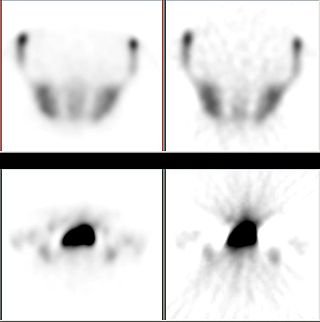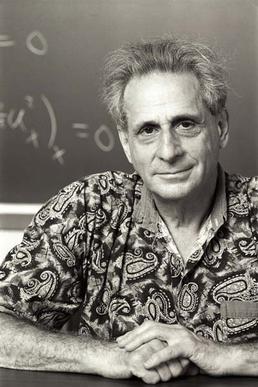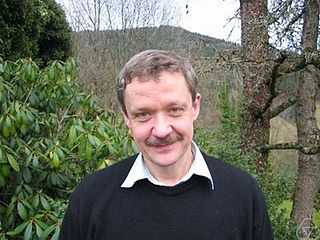Related Research Articles
An inverse problem in science is the process of calculating from a set of observations the causal factors that produced them: for example, calculating an image in X-ray computed tomography, source reconstruction in acoustics, or calculating the density of the Earth from measurements of its gravity field. It is called an inverse problem because it starts with the effects and then calculates the causes. It is the inverse of a forward problem, which starts with the causes and then calculates the effects.

Synthetic-aperture radar (SAR) is a form of radar that is used to create two-dimensional images or three-dimensional reconstructions of objects, such as landscapes. SAR uses the motion of the radar antenna over a target region to provide finer spatial resolution than conventional stationary beam-scanning radars. SAR is typically mounted on a moving platform, such as an aircraft or spacecraft, and has its origins in an advanced form of side looking airborne radar (SLAR). The distance the SAR device travels over a target during the period when the target scene is illuminated creates the large synthetic antenna aperture. Typically, the larger the aperture, the higher the image resolution will be, regardless of whether the aperture is physical or synthetic – this allows SAR to create high-resolution images with comparatively small physical antennas. For a fixed antenna size and orientation, objects which are further away remain illuminated longer – therefore SAR has the property of creating larger synthetic apertures for more distant objects, which results in a consistent spatial resolution over a range of viewing distances.

Electrical impedance tomography (EIT) is a noninvasive type of medical imaging in which the electrical conductivity, permittivity, and impedance of a part of the body is inferred from surface electrode measurements and used to form a tomographic image of that part. Electrical conductivity varies considerably among various biological tissues or the movement of fluids and gases within tissues. The majority of EIT systems apply small alternating currents at a single frequency, however, some EIT systems use multiple frequencies to better differentiate between normal and suspected abnormal tissue within the same organ.

Iterative reconstruction refers to iterative algorithms used to reconstruct 2D and 3D images in certain imaging techniques. For example, in computed tomography an image must be reconstructed from projections of an object. Here, iterative reconstruction techniques are usually a better, but computationally more expensive alternative to the common filtered back projection (FBP) method, which directly calculates the image in a single reconstruction step. In recent research works, scientists have shown that extremely fast computations and massive parallelism is possible for iterative reconstruction, which makes iterative reconstruction practical for commercialization.

Martin David Kruskal was an American mathematician and physicist. He made fundamental contributions in many areas of mathematics and science, ranging from plasma physics to general relativity and from nonlinear analysis to asymptotic analysis. His most celebrated contribution was in the theory of solitons.

Cathleen Synge Morawetz was a Canadian mathematician who spent much of her career in the United States. Morawetz's research was mainly in the study of the partial differential equations governing fluid flow, particularly those of mixed type occurring in transonic flow. She was professor emerita at the Courant Institute of Mathematical Sciences at the New York University, where she had also served as director from 1984 to 1988. She was president of the American Mathematical Society from 1995 to 1996. She was awarded the National Medal of Science in 1998.

Gene Howard Golub, was an American numerical analyst who taught at Stanford University as Fletcher Jones Professor of Computer Science and held a courtesy appointment in electrical engineering.
Compressed sensing is a signal processing technique for efficiently acquiring and reconstructing a signal, by finding solutions to underdetermined linear systems. This is based on the principle that, through optimization, the sparsity of a signal can be exploited to recover it from far fewer samples than required by the Nyquist–Shannon sampling theorem. There are two conditions under which recovery is possible. The first one is sparsity, which requires the signal to be sparse in some domain. The second one is incoherence, which is applied through the isometric property, which is sufficient for sparse signals. Compressed sensing has applications in, for example, MRI where the incoherence condition is typically satisfied.

Margaret H. Wright is an American computer scientist and mathematician. She is a Silver Professor of Computer Science and former Chair of the Computer Science department at Courant Institute of Mathematical Sciences, New York University, with research interests in optimization, linear algebra, and scientific computing. She was elected to the National Academy of Engineering in 1997 for development of numerical optimization algorithms and for leadership in the applied mathematics community. She was elected to the National Academy of Sciences in 2005. She was the first woman to serve as President of the Society for Industrial and Applied Mathematics.
Eli L. Turkel is an Israeli applied mathematician and currently an emeritus professor of applied mathematics at the School of Mathematical Sciences, Tel Aviv University. He is known for his contributions to numerical analysis of Partial Differential equations particularly in the fields of computational fluid dynamics, computational electromagnetics, acoustics, elasticity and image processing with applications to first Temple ostraca and recently deep earning for forward and inverse problems in PDEs,

Andrew Knyazev is an American mathematician. He graduated from the Faculty of Computational Mathematics and Cybernetics of Moscow State University under the supervision of Evgenii Georgievich D'yakonov in 1981 and obtained his PhD in Numerical Mathematics at the Russian Academy of Sciences under the supervision of Vyacheslav Ivanovich Lebedev in 1985. He worked at the Kurchatov Institute between 1981–1983, and then to 1992 at the Marchuk Institute of Numerical Mathematics of the Russian Academy of Sciences, headed by Gury Marchuk.

Frank Natterer is a German mathematician. He was born in Wangen im Allgäu, Germany. Natterer pioneered and shaped the field of mathematical methods in imaging including computed tomography (CT), magnetic resonance imaging (MRI) and ultrasonic imaging.
Carla Diane Savage is an American computer scientist and mathematician, a professor of computer science at North Carolina State University and a former secretary of the American Mathematical Society (2013-2020).

Yurii Nesterov is a Russian mathematician, an internationally recognized expert in convex optimization, especially in the development of efficient algorithms and numerical optimization analysis. He is currently a professor at the University of Louvain (UCLouvain).

Michael Elad is a professor of Computer Science at the Technion - Israel Institute of Technology. His work includes fundamental contributions in the field of sparse representations, and deployment of these ideas to algorithms and applications in signal processing, image processing and machine learning.
Liliana Borcea is the Peter Field Collegiate Professor of Mathematics at the University of Michigan. Her research interests are in scientific computing and applied mathematics, including the scattering and transport of electromagnetic waves.

Fioralba Cakoni is an American-Albanian mathematician and an expert on inverse scattering theory. She is a professor of mathematics at Rutgers University.
Jennifer L. Mueller is an applied mathematician and biomedical engineer whose research concerns inverse problems and their applications, particularly to problems in medical imaging related to electrical impedance tomography. She is a professor of mathematics at Colorado State University, where she also holds a joint appointment in the school of biomedical engineering and the department of electrical and computer engineering.
The AWM-SIAM Sonia Kovalevsky Lecture is an award and lecture series that "highlights significant contributions of women to applied or computational mathematics." The Association for Women in Mathematics (AWM) and the Society for Industrial and Applied Mathematics (SIAM) planned the award and lecture series in 2002 and first awarded it in 2003. The lecture is normally given each year at the SIAM Annual Meeting. Award winners receive a signed certificate from the AWM and SIAM presidents.
Akira Ishimaru is a Japanese-American electrical engineer and professor emeritus at Department of Electrical and Computer Engineering at University of Washington. He is best known for his contributions to the theory of wave scattering in random media.
References
- ↑ Birth year from ISNI authority control file, accessed 2018-11-26.
- 1 2 3 4 5 Curriculum vitae (PDF), October 2012, retrieved 2018-02-27
- ↑ Margaret Cheney at the Mathematics Genealogy Project
- ↑ Johansson, Sara (January 31, 2000), "Hon ska uppmuntra flickor att läsa teknik" [She will encourage girls to study technology], Arbetet (in Swedish)
- ↑ SIAM Fellows: Class of 2009, Society for Industrial and Applied Mathematics , retrieved 2018-02-27
- ↑ Review of Fundamentals of Radar Imaging: Lakey, Joseph D. (2010), Mathematical Reviews , doi:10.1137/1.9780898719291, ISBN 978-0-89871-677-1, MR 2553595
{{citation}}: CS1 maint: untitled periodical (link)